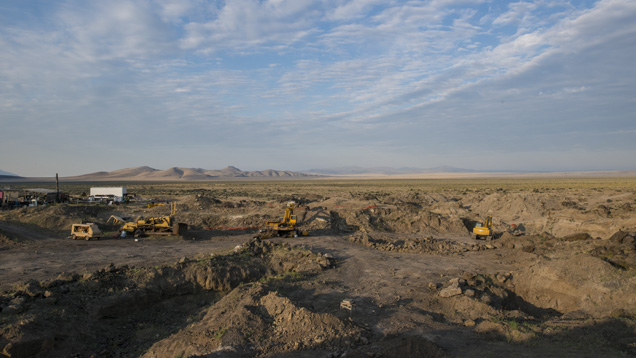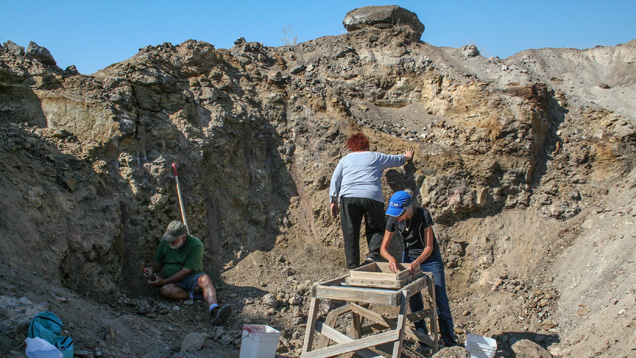A Sunstone Odyssey, Part 2:
The Dust Devil
October 20, 2013

INTO THE VALLEY
For the last couple of days we’ve been surrounded by the Ponderosa mine’s towering pines. Today, we’re a hundred miles farther south—and a thousand feet lower—on the road to the Plush sunstone mining area. Our next stop is Don Buford and Terry Clarke’s Dust Devil Mine in the heart of the Rabbit Basin. This is expansive country: forbidding volcanic hills form steep ridges that loom above flat, open valleys dotted with sagebrush. The high desert has its own unique beauty.Don’s email also told us that any car with decent tires would do, and after thirty bumpy miles, we arrive at the mine. As Don assured us: “You can’t miss us, lots of trailers and shakers and conveyors.”


Don mentions that Tiffany & Co. of New York mined clear feldspar here as a diamond substitute as recently as the 1950s. Their endeavors led to the gems’ local name: “Plush diamonds.” He adds that they only mined close to the surface and “didn’t get deep enough to get the really nice colored stones.”
MASTERS OF MECHANICAL IMPROVISATION
We ask how Dust Devil got its start, and Don tells us it began as an Explorer Post for the Boy Scouts of America. “We were just looking for something for our scouts to do,” he continues. “We came down here to find some mining claims, and once I started digging, I was very fascinated with the beauty of the stones and how totally different they are from anything else.”That was the catalyst. Terry and Don started digging for sunstones on weekends and vacations. “We started off with shovels, sixteen-pound sledgehammers, and hand screens, and eventually bought an ancient backhoe.”

THE MINING PROCESS
Don explains that the mine’s location is very favorable. “We’re on the edge of what was a great inland sea, and a river flowed right past our camp, so we have a lot of decomposition of the basalt that holds the sunstone.” This makes the rocks that contain the gems softer and easier to mine.
The shaker removes material that’s less than two inches and more than five-sixteenths of an inch in size, Don explains. The trommel washes the concentrate, which then goes to either a one-cubic-yard hopper, where people can pick it off a belt, or to a sophisticated optical sorting machine.

DESERT WISDOM: SHARP-EDGED STONES, TALL SAGEBRUSH, AND BIG ANTHILLS
After a lifetime of working the desert for sunstone, Don turns his miner’s eye to the landscape for clues. The first things he looks for on the surface are stones with sharp edges, which indicate they’ve been recently deposited and there’s probably more underground. He tells us that worn stones with sand-blasted edges might have come from some distance away, or might even have been on the surface for 100,000 years.Next, he seeks out the tallest sagebrush because it can indicate easier mining conditions. Much of the rock covering the sunstone-bearing basalt is heavy, requiring drilling and blasting, but tall sagebrush—above five or six feet—is a good indication that the plant’s roots are able to reach water, and that means, as Don explains, “the rock is fractured…we can get through it.”
Finally, he advises not to forget the ants. The desert supports vast populations of them. Don indicates that they require a little respect: “These are red ants that have a really nasty bite.”
Around a big ants’ nest, he says, they’ll completely clear a circle ten feet in diameter, then use little pebbles and sunstones to build their mound. They even arrange them close together so when it rains, the water runs off. There’s another benefit: sunstones reflect the light, so in the summer they help regulate the anthill’s heat.

ENVIRONMENTAL CONSTRAINTS AND CHALLENGES
Unlike the Ponderosa, which has several natural springs on the property, there’s absolutely no water at the Dust Devil Mine. The Bureau of Land Management (BLM)—the federal agency that administers public lands—prohibits any kind of permanent development in the Rabbit Basin and insists the land be restored to its pre-mining state.Don explains the location’s challenges: “We’re 21 miles from the nearest electrical power, so we make our own power…We haul our drinking water in from 30 miles away. Our mining water comes from a well that’s six miles away.”
All the water used in mining is extensively recycled. A series of six holding tanks recirculates the 10,000 gallons of water used for washing the concentrate. They allow progressively finer material to separate out before the water is used again. As Don says, “This is the desert, and water is hard to come by…so we don’t use more than we have to.”
When mining ceases, the miners will have to re-contour and replant the area with native species. On his own initiative, Don is planting the native bunch grasses that grew in the valley before extensive sheep farming eradicated them. “We’re putting it back to the way it was before the white man came here and had an effect on the land,” he says.
The desert is hard on men and machines. The gritty attrition of dust and the ringing impact of metal on rock take their toll. You have to be tough and mechanically minded to make it here. “We’re pretty self-sufficient,” he says. “We have a lot of equipment. It’s old equipment and it breaks down a lot, but we have the tools and technology to repair almost anything.”


Don’s next answer reinforces the fact that he has already done more than anyone to raise this gem’s profile among jewelry designers: “When we got into the very, very large stones in this pit, which at that time were the largest that anyone had ever found, we took our best material to the Tucson International Gem Show.”
He explains how they met with artists that they enjoyed working with and gave them the stones so they could carve or cut them and enter them into prestigious competitions run by the American Gem Trade Association (AGTA). “Over the years,” he continues, “we’ve won sixteen Cutting Edge awards with our stones. We try to be real humble about it, but several of those artists have said that a lot of their fame has come from cutting our stones. Had we not given them those stones, they wouldn’t be where they are today.”
BEAUTIFUL SUNSTONE
For Don, red gems with the glitter of native copper are the most fascinating: “I like the red stones with the copper schiller bars running through them.” Although bicolor gems and stones displaying red to green dichroism might be more rare, he prizes these gems the most. “The reds with the schiller are just very, very dynamic, and there’s nothing else in the world that looks like it.”

We also asked mine employee Mark Shore what brings him to the desert, what drives him to come out here to spend his summers at the mine, what makes him pause to pick a feldspar crystal off the ground. I think my question stings him a little: “Why pick them up? Because they’re beautiful!”
To Mark, a sunstone in your hand is a very special thing: “It’s like holding air or water in your hand…” And his favorite type? “There’s no other stone like a schiller…it dances inside: it’s alive!”
THE BEAUTY OF THE DESERT
After just a few days in the high desert, I think we are becoming attuned to its beauty: the clarity of the air, the lure of a red glint of hidden sun in the rock. There’s a lightning storm on our last evening that shocks the sky with blasts of sudden light. We all stay up to watch the hills light up like daytime.The next morning we leave to visit the last mine on our trip, a distinctly different one where the miners dig into the flank of a small volcanic hill—Sunstone Butte. As we drive off, some of Don’s words ring in my ears: “These stones are mined by hardworking Americans…there’s nothing like it in the world…and Americans should want to buy our stones.”
So, if your car breaks down on Hogback or you get a puncture on Nasty Flat Road, pray you run into Don or Terry. They will fix your flat and set you right.

Duncan Pay is editor-in-chief of Gems & Gemology, Robert Weldon is manager of photography and visual communications at GIA in Carlsbad, and Kevin Schumacher is digital resources specialist at GIA in Carlsbad.
The authors would like to thank all the sunstone miners for their generosity of spirit and the time they committed to showing us every detail of their mining operations; nothing was too much trouble, and we were made to feel at home everywhere we visited. We thank John Woodmark and his crew at the Ponderosa mine; Don Buford, Terry Clarke, and Mark Shore at the Dust Devil mine; Dave Wheatley, Tammy Moreau, and David Grey at the Sunstone Butte mine; along with Nirinjan Khalsa and especially Mariana Photiou for their help liaising with the miners.




























.jpg)


